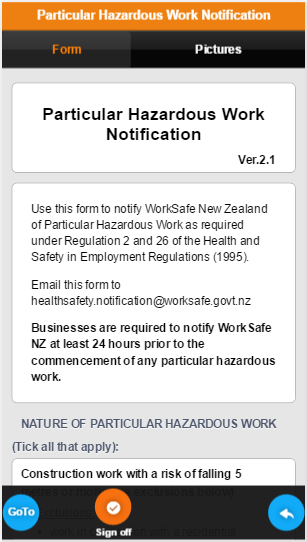SmartTrade Blog
What is happening at SmartTrade
How SmartForms can help NZ businesses comply with the Health and Safety at Work Act
- Font size: Larger Smaller
- Hits: 41184
- 0 Comments
Major changes to New Zealand’s Health and Safety laws took effect on 4 April 2016!
-
worker participation - Health and Safety Representatives (HSRs) and Health and Safety Committee (HSCs); and
-
the need to notify WorkSafe NZ prior to the commencement of particular hazardous works.
|
Seek advice! We strongly recommend SmartTrade’s New Zealand customers visit the WorkSafe New Zealand site and get professional advice, to make sure they have an in-depth understanding of how the (HSWA) will affect their business. |
An introduction to the Health and Safety at Work Act 2015
- Introducing a new legal concept of a Person Conducting a Business or Undertaking (PCBU). A PCBU will usually be a business entity, such as a company, rather than an individual;
- Imposing a new due diligence obligation on officers. Officers are directors and other people who make governance decisions that significantly affect a business;
- Imposing a new duty to take “reasonably practicable steps”;
- Including a new object of securing workers’ health and safety;
- Promoting continual improvement and good practice, benchmarked on internationalstandards;
- Implementing a presumption in favour of the highest level of protecting workers from harm;
- Increasing the penalties for noncompliance.
-
Identifying health and safety hazards and risks, and taking steps to prevent these from happening;
-
Making sure health and safety in your business is led from the top, has involved and is understood by your staff, and is reviewed regularly;
-
Holding regular training on health and safety matters;
-
Engaging workers in health and safety matters that affect them;
-
Supporting all officers to get up to date with health and safety issues and key risk factors;
-
Reporting and monitoring health and safety goals;
-
Regularly reviewing any incidents;
-
Carrying out frequent health and safety audits.
|
SmartForms, an excellent tool for managing workplace safety compliance in the field! The ever increasing complexity of workplace safety and compliance requirements means more and more forms are needed to be completed and managed. For more information about SmartForms please contact our sales team. |
 |
Worker Participation - Health and Safety Representatives (HSRs) and Health and Safety Committee (HSCs)
All businesses with 20 or more workers, or who are in one of the high-risk sectors or industries listed in the Regulations, must:
- arrange the election of HSRs if requested by a worker, and
- consider whether existing worker participation practices are sufficiently effective and whether to set up an HSC if one is requested by an HSR or five or more workers.
Schedule 2 of the Act lists high-risk sectors or industries as: - Aquaculture
- Forestry and logging
- Fishing, hunting, and trapping
- Coal mining
- Food product manufacturing
- Water supply, sewerage, and drainage services
- Waste collection, treatment, and disposal services
- Building construction
- Heavy and civil engineering construction
- Construction services
Notifying WorkSafe NZ of particular hazardous works
Businesses may not know that they’re legally required to notify WorkSafe NZ at least 24 hours prior to the commencement of a particular hazardous work.
Notifiable work is defined by the regulations as:- Any restricted work, as that term is defined in regulation 2(1) of the Health and Safety in Employment (Asbestos) Regulations 1998:
- Any logging operation or tree-felling operation, being an operation that is undertaken for commercial purposes:
- Any construction work of one or more of the following kinds:
a. Work where workers could fall five metres or more, excluding work on a two-storey house, or work on a power or telephone line, or work carried out from a ladder only, or maintenance or repair work of a minor or routine nature;
b. The erection or dismantling of scaffolds from which a person could fall five metres or more;
c. Every excavation more than 1.5m deep in which people are required to work and which is deeper than it is wide at the top;
d. Any form of tunnel or drive where workers work underground, irrespective of timbering or support;
e. Those excavations where the excavated face is steeper than one horizontal to two vertical;
f. Any construction work where explosives are used or stored;
g. Work such as diving, where construction workers breathe air or any other gas that has been compressed or is under pressure;
h. Lifts of half a tonne (500 kg) or more a vertical distance of 5 m or more carried out by use of a lifting appliance other than by a mobile crane, excavator or forklift.
|
Particular Hazardous Work Notification SmartForm available! SmartTrade Mobile users wishing to complete Particular Hazardous Work notifications electronically and email these to WorkSafe NZ can purchase the applicable SmartForm for $ 95 plus GST. The price includes our customising the SmartForm with your company logo plus any minor modifications you want made, provided the modifications are advised to us within a month of us emailing you the SmartForm. For more information about SmartForms please contact our sales team. |
 |
- Any restricted work, as that term is defined in regulation 2(1) of the Health and Safety in Employment (Asbestos) Regulations 1998:
Comments
-
Please login first in order for you to submit comments

